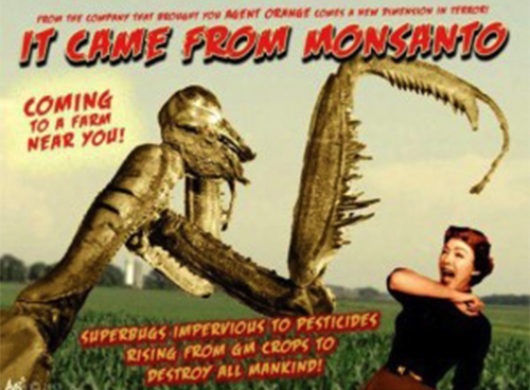Understanding GMOs
Firstly, let’s clearly establish that genetic engineering of food is not the same as selective breeding. Selective breeding is the process of breeding together specific plants or animals in order to achieve specific desired traits. Selective breeding is the process that has led to the hundreds of different dog breeds we see today. Crossbreeding certain plants has led to things like the pluot (a plum and an apricot), or the rainbow colored cauliflower.
Farmers, or animal breeders, select from populations with desired traits, and they continue to breed and select, breed and select- until the desired trait arrives. This process, though it may also have its share of problems, also has its benefits (the orange cauliflower, for example, has 25 times the beta carotene as regular cauliflower; however, many dog breeds are also fraught with physical problems, like hip dysplasia). The process of selective breeding still relies on natural law. The natural processes of reproduction are still at play.
The biotech industry thinks that natural reproduction is a game of roulette when it comes to achieving desired traits, as well as being too time consuming. They would rather force the issue. And, I mean force both philosophically and physically. The process of genetic engineering mixes genes from totally unrelated species- like putting human brain cells in to pigs (true), or crossing a fish with a tomato(true). Potatoes have been developed that glow in the dark when they need to be watered. Have farmers actually been failing to water their potatoes for all these thousands of years?
There have already been field trials in which they have injected human genes in to corn, rice, and sugarcane. I don’t know any person that actually wants to consume corn with human genes in it…although the Monsanto people seem to think it’s okay. This starts to beg the question of- what is cannibalism? And, if we were to eat food containing human cells, what would be the outcome? Where are they getting these human cells- from what humans? How do we know the human cells they chose to use are free from disease or genetic mutation? We know what happens when cows are fed cow meat- they develop Mad Cow Disease. Perhaps someday we will see a Super-Mad-Human-Disease. I would argue that we are already seeing it- what’s with all the school shootings? No one can ignore the increase in cases of autism, ADD, food allergies, and the fact that infertility rates are at an all time high.
In genetically modified organisms, the DNA structure- the very basic coding for our cells, has been altered in a way that does not occur naturally. The very DNA structure of a plant is broken and forcibly injected with cells carrying the desired traits, however, they usually need a carrier- or mule- and this is often a bacteria or virus. In the case of genetically engineered food crops, they have been using the cauliflower mosaic virus (CaMV). It can be compared to the human immunodeficiency virus (HIV).
Let me interject and make something very clear. Injecting new DNA is not like injecting something in to your blood stream. It is more like taking out your blood cells and actually changing what the blood cells are (by forcibly injecting foreign DNA into the cells, then allowing those cells to mutate), and then putting that in to your body- and expecting that blood to still function as your old blood. It is no wonder that there is rejection, and that a whole host of unknown mutations, superviruses, and antibiotic resistant disease can now occur.
And what about the proliferation of these plants? Once they are out in the world- the seeds are free to move through the air and via bird droppings, free to mix with wild and traditional plants. These genetically modified plants cannot be recalled. They cannot be undone.
Have you heard of (one of) the farmer who was sued by Monsanto- because his canola crops became contaminated with their genetically modified seed? GMO seed was being planted by some nearby farmers, and the GMO canola mixed with his heirloom canola (which he had been growing for generations). The farmer didn’t want their GMO seeds! He called Monsanto to ask them what to do about it, and they not only encouraged him to purchase their chemicals to kill off his own plants (any plants left standing after the chemical assault would clearly be Monsanto’s GMO plants, because they are engineered to withstand the chemical sprays), but they then launched an investigation of this man’s farm, and eventually sued him in court for patent infringement (since he was not authorized to grow their seed). Here is the MOST disgusting part—clearly the judge was not human, because Monsanto (a billion dollar company) won the lawsuit against the independent farmer! Everyone knew quite clearly that the seed had unwittingly spilled or drifted onto this farmer’s land! It’s so outrageous that I just cringe every time I think about it: http://www.organicconsumers.org/ge/schmeiser.cfm.
This was the first lawsuit of many by Monsanto against a small farmer.
Here you can watch the first ten minutes of a great documentary that illustrates what is going on with the food industry: http://www.thefutureoffood.com/onlinevideo.html
When were GMOs invented?
In 1953, two researchers- J. Watson and F. Crick- decoded the structure of the double helix of DNA, which, in 1962, led them to winning the Nobel Prize. This was the beginning of molecular biology, and GMOs were first created in the 60s, which was also the time when Monsanto became interested in this new technology. In 1972, a scientist named P. Berg managed to combine two pieces of DNA from different species, and thus began a new era where the “species barrier” was no longer there! Research really began to take off, and there was a great boom in the creation of biotech companies. Two decades later, genetically altered food was brought to market. (source: http://www.combat-monsanto.co.uk/spip.php?article222) According to Susan Wright, a sociologist, “The dawn of genetic engineering coincided with the emergence of a new ethic, one profoundly shaped by commerce.”
Why do big food companies welcome the use of GMOs?
They claim:
In addition to the visual perfection that GMOs boast, proponents claim that they have more profound advantages as well:
-GM crops can be made resistant to viruses, fungi and bacterial growth.
-GM crops can be engineered to grow faster.
-GM crops can be engineered to be naturally pest-resistant, undermining the need for pesticide chemicals.
-GM crops can be engineered to tolerate extreme weather conditions, such as cold fronts or droughts, allowing for a geographically diverse range of growth sites.
-GM crops can be engineered with added vitamins and minerals, which is potentially beneficial in third world countries dealing with malnutrition.
Unfortunately, none of this has been proven true! In the case of viruses and pests- it has only been found that these new engineered crops create super-bugs and super-viruses! The pests are simply becoming bigger and badder, thus it takes bigger and badder chemicals to kill them. The biotech companies are, in fact, now creating what they call “stacked trait” seeds to combat the new resistant weeds and bugs (according to www.themindfulword.org). They are splicing more than one set of DNA into plants to contain many levels of resistance. We are on a genetic engineering treadmill…where does it stop?
No GM crop has produced more nutritious food, and they have not managed to end world hunger. The surplus of foods has actually gone in to the huge growth of the packaged food/processed/junk food industry. Completely useless “foods” have been created simply as containers for the excess GM corn, soy and sugar.
A great example of a useless food, which sees millions in sales and is marketed as a healthy food for our children, is the “lunchable”. This product is an actual trash bin for cheap, excess genetically modified corn and soy, with a dizzying dose of chemical additives to boot. With a fat, sugar and salt content being off the charts for recommended daily dose, it only contains about 1 gram of fiber. In the example of the “Mess with Your Mouth: Turkey & American Stackers”- the turkey alone has 14 ingredients. Call me a radical, but I think the only ingredient in turkey should be TURKEY! Let’s put it this way, if I had to chose between feeding my child a Lunchable for lunch, or nothing…I would go with the nothing (assuming I am able to give my child breakfast and dinner, and not approaching the subject of child hunger). Products like these (and they are products, not food) were simply created to make money for the company (this one being Kraft Foods, who is also strongly opposed to labeling of GMOs). They are created with high fat, sugar and salt content in order to addict people, and contain more food-like substances and chemicals than actual quality food and nutrients.
What are the concerns of growing & consuming GM foods?
There are many concerns involved with the creation of genetically engineered plants- from environmental concerns, involving issues of superweeds and superbugs, to human concerns involving consumption of unrecognizable proteins. The following is an excerpt from: http://www.themindfulword.org/2012/gmo-genetically-engineered-food/
“In addition to Roundup Ready GE crops, biotech companies such as Monsanto have also bioengineered crops that contain a slight variation of a naturally occurring pesticide, called BT toxin. BT stands for bacillus thuringiensus. This bacteria naturally occurs in soils and secretes a toxic substance that protects it against other soil organisms. Monsanto has taken this substance secreted by b. thuringiensus and modified it to increase its potency thousands of times. When the gene that codes for Bt-toxin is spliced into GE seeds the plant systemically (throughout the whole plant)produces Bt toxin in a modified and increased concentration than what is naturally found in soil frombacillus thuringiensus.
Bt-toxin in this synthetic and concentrated form has no research or studies to prove its safety for human consumption. It’s one thing for bacterial poison to exist in the dilution of soil and quite another for a variation of this poison to be artificially and systemically produced in a plant in extremely high concentrations and then directly consumed by humans.
Many experts and lay people are particularly concerned about the health and environmental impacts of cross-species genetic engineering. In the case of the gene for Roundup Ready resistance and Bt-toxin, genetic material from bacteria is being inserted into plants, a process that would likely never occur in nature. Biotech companies argue that there is no need to worry because it is only one gene being spliced into the seed. But other scientists argue that even one gene spliced into a seed creates relatively massive collateral damage in how other genes in that plant will function. Genes code for proteins, which perform all sorts of functions in our bodies. With aberrant genetic coding, anomalous proteins are produced, which have unknown and potentially devastating effects on our health and in the environment, most notably allergic reactions in humans. GMO-induced allergies are a primary concern among health experts and scientists critical of GMOs.”
“With the development of Roundup Ready resistant weeds and Bt-toxin-resistant worms, we arrive at the current situation where DowAgroscience and Monsanto are awaiting approval of their new stacked corn variety that’s both Roundup resistant and 2,4-D resistant. 2,4-D is the highly controversial and potent herbicide comprising about half the volume of the cancer-causing defoliant used in Vietnam, Agent Orange. If the corn variety is approved, this means that each year GMO farmers will now spray hundreds of millions of pounds of Roundup and 2,4-D on their new generation GMO crops.
‘Many studies show that 2,4-D exposure is associated with various forms of cancer, Parkinson’s Disease, nerve damage, hormone disruption and birth defects,” Wenonah Hauter, executive director of Food & Water Watch, told Reuters reporters. “USDA must take these significant risks seriously and reject approval of this crop.’ “
The American Academy of Environmental Medicine doesn’t think GMOs are safe, either. They’ve reported that animal studies have shown health risks such as infertility, inability to regulate insulin levels, immune deficiencies, accelerated aging, and changes in major organs and the gastrointestinal system. One of the biggest concerns is that GM foods can create symptoms that are difficult to detect or relate to their source, such as allergies, new diseases and nutritional deficiencies. (source:http://www.responsibletechnology.org/gmo-dangers)
Scientific findings have shown:
-
Thousands of sheep, buffalo, and goats in India died after grazing on Bt cotton plants
-
Mice eating GM corn for the long term had fewer, and smaller, babies
-
More than half the babies of mother rats fed GM soy died within three weeks, and were smaller
-
Testicle cells of mice and rats on a GM soy change significantly
-
By the third generation, most GM soy-fed hamsters lost the ability to have babies
-
Rodents fed GM corn and soy showed immune system responses and signs of toxicity
-
Cooked GM soy contains as much as 7-times the amount of a known soy allergen
-
Soy allergies skyrocketed by 50% in the UK, soon after GM soy was introduced
-
The stomach lining of rats fed GM potatoes showed excessive cell growth, a condition that may lead to cancer.
-
Studies showed organ lesions, altered liver and pancreas cells, changed enzyme levels, etc. (also from www.responsibletechnology.org)
Companies like Monsanto go to great lengths to hide information like this. They spend millions of dollars on campaigns against labeling, and assert that labeling of GMOs is not necessary- that they are completely harmless to us. If this is the case- if GMOs are completely benign and of no concern- why do they go to such great lengths and spend so much money preventing the labeling of GM foods? If GMOs are so great, then why aren’t they advertising it on labels? The truth is- they work very hard to deceive us because that is what is good for their sales. Companies are driven by sales, and corporate food giants are out of control.
They say that there are no human clinical trials of GM foods, so there is no way to conduct safety evaluations. However, the horrific truth is that we all are part of the greatest human biological experiment ever conducted, partly without our knowledge, and wholly without our consent. We are the trial- because GMOs are already a large part of our food system (80%), and they are not required to be labeled- so people are consuming these untested new organisms, and we do not know the full potential of the outcome. That is what I call an experiment. It is one I don’t want to be a part of, and I especially don’t want my child to be part of.
What foods contain GMOs?
You can without a doubt be assured that if you are consuming a commercial brand packaged food that contains corn (that includes high fructose corn syrup), sugar (from sugar beets), soy or canola- it has been genetically modified. The most commonly genetically engineered food crops are corn, soy, sugar beets, canola, alfalfa, Hawaiian papaya, tobacco and some zucchini and crookneck squash. Surprisingly, wheat and potatoes are not yet genetically engineered, but I would still recommend organic. It is especially important to consume organic potatoes, as they grow in the ground and absorb toxins and pesticides directly from the soil.
Another thing to look out for is meat and dairy. Cows are injected with genetically engineered hormones, so it is in their milk and meat. They are also fed genetically engineered corn (which they should not be eating, and raises a whole other issue).
How do I avoid GMOs?
There are numerous health reasons to avoid packaged and processed foods, and right now I think the biggest one is in avoiding genetically modified organisms. Aside from avoiding packaged/processed foods, chosing organic foods is another assurance. Organic labeling laws do not allow the use of GMOs, so if your food is labeled organic- it is GMO free. You can also look for the new “GMO verified” label on your foods. You can read more for them here:http://www.nongmoproject.org/
There is also a new “grassroots alternative” to the certified organic label. It offers an option to farmers who simply cannot afford the cost of organic certification, or do not meet every last criteria, but otherwise have good agricultural practices and do not use genetically modified seed. So, start to look for the “certified naturally grown” labeling. You can learn more at their site:http://www.naturallygrown.org/
There is a great instructional on how to avoid GMOs here: http://www.wikihow.com/Avoid-Genetically-Modified-Foods
How do I get involved?
The most immediate way to fight against the use of GMOs, as well as to avoid eating them, is to fight with your dollars. Don’t buy it! Encourage everyone you know not to buy it. Buy organic or verified-GMO free foods. Start cooking at home. Talk to people- tell your favorite restaurants that you enjoy their food, but you aren’t going to be eating it anymore until they stop serving GMOs.
Read more. Keep reading about what’s going on with labeling laws and what anti-GMO groups are doing. Read your labels! Here’s a site that has some of the latest headlines on GMOs:http://wakeup-world.com/category/health-wellbeing/gmo-genetically-modified-organisms/
We need to Keep Fighting for Labeling of Genetically Engineered Foods!
To sum it up- if you understand what a GMO is, you can plainly see for yourself that it is not a good thing. The research that is out there is not good. Other countries have completely banned use of GMOs, or they have strict labelling laws. We need to all do our part to get the government to pay attention to this very serious situation. Signing petitions and writing letters is great- but the greatest and most impactful thing you can do is very simple- DON’T BUY GMOs. If the market demand were not there, they wouldn’t make them. But Americans are blindly enabling this industry. Armed with a little knowledge and a bit of resignation, you can avoid GMOs. Cook at home, buy local and organic foods, look for certifications on your food that they do not contain GMOs. We absolutely need to remember- you really are what you eat.



